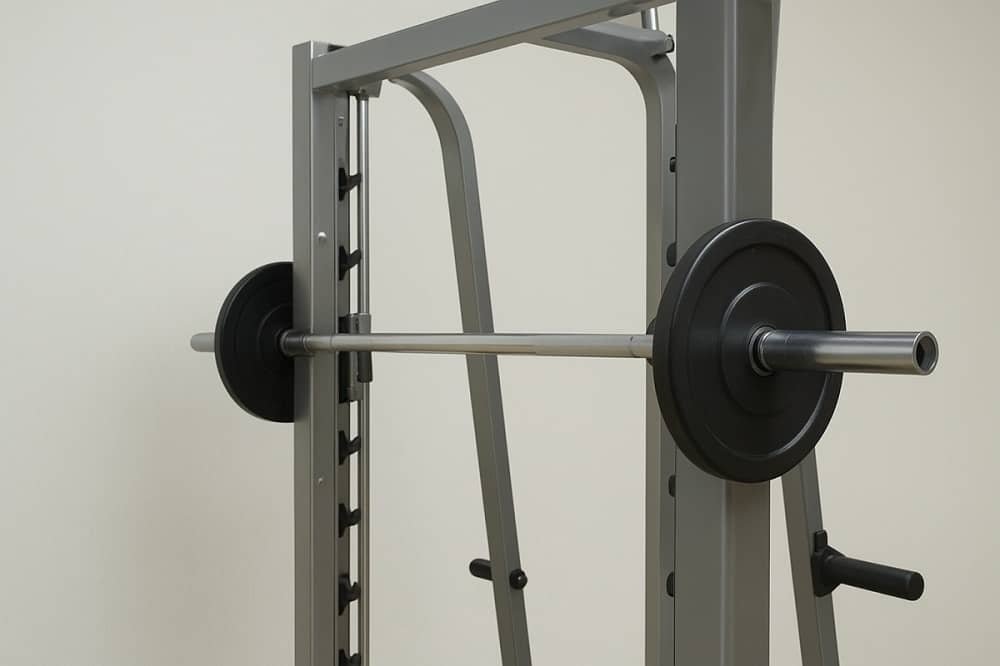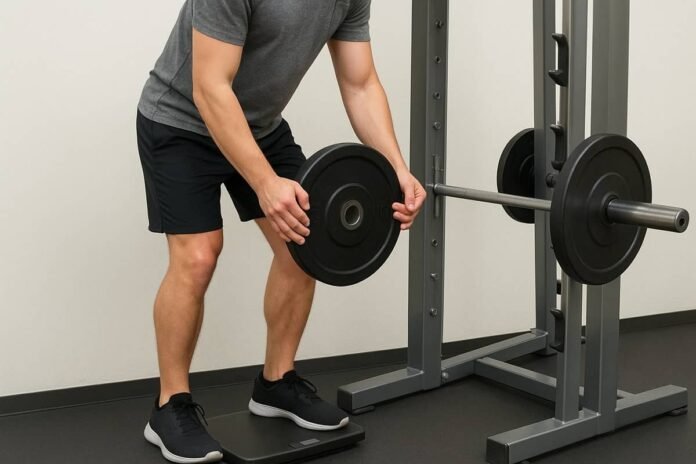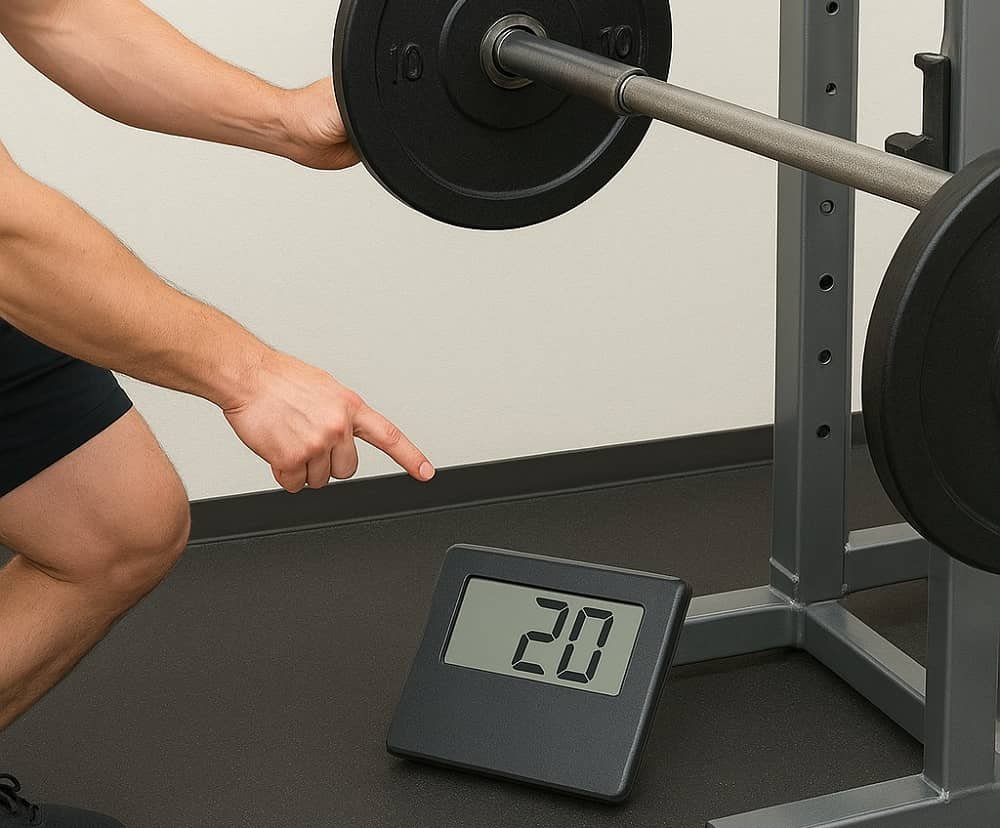If you’ve ever asked yourself “What is the Smith machine bar weight?”, you’re not alone. Unlike a standard Olympic barbell with a fixed and widely-known weight, the bar in a Smith machine can vary substantially depending on design, counter-balance systems, manufacturer and model. Understanding the Smith machine bar weight matters for logging your lifts accurately, planning progressive overload, and comparing workouts across gyms or machines.
In this long-form guide we’ll dive into what influences the weight, how to estimate it, why it matters for your training, and practical tips for use. We’ll walk you through everything you need — rooted in expert information and real-world gym experience. Let’s get started.
What is a Smith Machine and How It Differs from a Free-Weight Barbell
A Smith machine is a piece of strength-training equipment in which the barbell is fixed to vertical (or slightly angled) rails and slides up and down within that track. This design reduces the need to stabilise as much as you would with a free barbell, offers built-in safety catches or lock-outs, and allows for a somewhat safer solo lifting environment.
In contrast, a free barbell (such as a standard Olympic bar) is completely free to move in multiple planes and relies entirely on the lifter’s stability and control. With a free bar, the bar weight is consistent (e.g., 45 lb/20 kg in many gyms). But in a Smith machine, the bar’s “starting weight” or “felt weight” can differ widely due to manufacturer features.
Because the Smith machine bar travels on a guided path, manufacturers often design the bar and support system differently (e.g., using lighter materials, bearings, or counter-balance pulleys). As such, it is inaccurate to assume “the Smith machine bar weighs 45 lb” in every case.
Must Read: Ohio Power Bar vs. Texas Power Bar
Why the “Smith Machine Bar Weight” Varies

There are several key reasons why the Smith machine bar weight (or the “felt weight” of the bar) is not standardised:
- Counter-balance systems
Some Smith machines use pulleys, cables, or counter-weight plates to lighten the effective weight of the bar for the lifter. According to one source, “Smith bars can weigh between 4 kg-20 kg, with most models falling in the 8 kg-12 kg range.” The bar may weigh more in raw terms but the counter-balance reduces what the user feels.
- Rail angle and bearings
The design of the machine (vertical vs angled rails), the type of bearing mechanism (linear, roller, bushing), and how much friction or assistance there is will impact how heavy the bar “feels”. One review notes: “Depending on the type of Smith machine you are using … the barbell on a linear bearing Smith machine can feel quite heavy.”
- Bar material and build
Some machines use lighter materials (especially for home-gym models) because the bar does not need to withstand the same free-weight bending. As one blog states: “The smith machines tend to be lighter than 45 lbs … the usual weight in this regard lies between 30-40 lbs.”
- Manufacturer and model differences
Different gym chains and home equipment manufacturers use different machines. One brand may list the “starting resistance” of the bar at 30 lbs (13.6 kg) for a particular model. Because of these variations, the only safe way to know the bar weight is to check the specific machine or measure it.
For these reasons, you’ll see a wide range of figures for “Smith machine bar weight”.
Typical Weight Ranges for a Smith Machine Bar
While there is no single universal weight, here are common ranges you’ll encounter:
Counter-balanced commercial machines
For machines with counter-balance systems (often found in commercial gyms):
- Some machines list the effective starting bar weight as ~5 to 20 lbs (2.5-9 kg).
- One blog noted: “Smith machine bars can weigh between 4 kg-20 kg, with most models falling in the 8-12 kg range.”
These versions are designed to make starting the movement easier (especially for beginners or rehab) by reducing the effective load of the bar itself.
Linear bearing / non-counterbalanced models
For machines that more closely mimic free-bar performance (often home-gym or more advanced designs):
- A typical weight range is around 15-25 lbs (6.8-11.3 kg) according to some sources.
- Others report “average … around 15-20 kg (33-44 lb).”
So you might find a Smith machine with a bar weight of ~33-44 lbs (15-20 kg).
Variations and extremes
- Some sources report up to 45 lbs (20 kg) for certain models.
- Others note that because of counterbalance the “felt weight” may be as low as 6 lbs.
Quick Summary Table
| Type of Smith Machine | Typical “Bar Weight” Felt by User |
| Counter-balanced (commercial) | ~5-20 lbs (2.5-9 kg) |
| Non-counterbalanced / home-gym style | ~15-25 lbs (6.8-11.3 kg) |
| Advanced / heavy-duty model | Up to ~33-45 lbs (15-20 kg) |
Given this variability, it’s crucial to check your specific machine or ask gym staff.
How to Estimate or Measure Your Smith Machine Bar Weight
If your gym doesn’t list the bar weight, here are a couple of ways to estimate or measure it:
Method 1: Manufacturer specs
Look up the brand and model of the Smith machine in your gym. Many manufacturers publish the “starting resistance” or bar weight. For example: one machine lists “Starting Resistance: 30 lbs (13.6 kg)” in its specs. If you can identify the model, you can more accurately
log what you’re lifting.
Method 2: Scale method
One accurate method is:
- Use a floor scale or digital scale.
- With no plates on the bar, step on the scale holding/resting the bar (if safe) and note the weight difference.
- Alternatively, carefully rest the bar on the scale (on a box or stand) and read the weight. One blog describes exactly how to do this: “Place the box under the Smith bar. Put the scale on the box and bring the bar down to rest on it. … The weight you seek is indicated by the reading”
Method 3: Ask gym staff or check sticker
Some machines have a sticker showing “bar only” weight or “starting resistance”. Ask staff if they know the brand/model and what the spec
is.
Things to watch out for
- Even when you know the bar weight, things like friction in the rails or bearings may slightly increase what you feel lifting.
- Don’t assume the bar is the same between gyms; machines differ.
- Always count the bar weight when logging your lifts if you want accuracy.
Why Knowing the Smith Machine Bar Weight Matters for Your Training
Why is this seemingly small detail important? Here are several good reasons:
Progressive overload & tracking
To improve strength or muscle, you’ll increasingly load your lifts over time (progressive overload). If you don’t know how much the bar itself weighs, you may mis-log how much you’re actually lifting. For example, if you add plates equating to 100 lbs but the machine’s bar feels like 20 lbs, your total is 120¬lbs — not just the plates. Many sources stress this.
Consistency across gyms
If you train at different gyms with different Smith machines, you may think you’re lifting the same weights but actually the starting load differs. Over time this can lead to inaccurate comparisons of your progress. A blog writes: “Depending on the specific type of machine, the barbell on a Smith machine may add anywhere between 5 and 45 pounds to the equation.”
Safety & form
If you under-estimate the weight of the bar, you might accidentally overload beyond your capacity without realizing. Conversely if you over-estimate, you may hold back. Knowing approx what you’re lifting helps you plan sets, reps, rest, and form.
Programming and plate selection
When you select plate sizes (e.g., adding 10 lb plates either side), you should add in your bar starting weight to reach your target. For example, to lift 150 lbs total, if your Smith bar equals ~20 lbs, you’ll need 130 lbs of plates, not 150 on each side.
Examples of Smith Machine Bar Weights by Brand / Model
Here are some real-world examples (brand/model may vary):
- Life Fitness Smith Machine: “Starting Resistance: 30 lbs (13.6 kg)” listed in specs.
- One site lists: “Life Fitness Signature Smith Machine bar weight is 20 lbs (9 kg) and is counterbalanced on an angle of 7 degrees.”
- Another lists a generic average for Smith machine bars as “around 15–20 kg (33–44 lbs).”
These examples illustrate how widely the figures can vary depending on design.
Comparison Chart: Smith Machine Bar Weights by Brand/Model
Here’s a comparison chart of popular Smith-machine models that list their bar weights or starting resistance, followed by some recommended models you could consider. This will help you see variations by brand/model and pick one that fits your training needs.
| Brand / Model | Bar Weight or Starting Resistance | Notes / Source |
| Life Fitness Smith Machine (model SSM) | 20 lb (9 kg) bar weight listed in specs. | Commercial grade, 7° bar angle. |
| Hammer Strength Smith Machine | ~20 lb (9 kg) according to one summary. | Popular commercial brand. |
| Cybex Smith Machine | ~15–20 lb (~7–9 kg) in guide list. | Entry to mid-range commercial models. |
| Technogym Multipower / Smith Machine | 8 kg (~17.6 lb) listed in one guide. | European brand; value of bar + counterbalance lower. |
| Generic Smith Machines (averages) | 4 kg to 20 kg (≈9–44 lb) total range. | Reflects wide variability across machines. |
Key takeaway: While a standard Olympic barbell is 45 lb (20 kg), the bar in a Smith machine may weigh far less (sometimes under 20 lb) depending on counterbalance systems, bearings, rail angle, etc. See the wide spread above.
How to Use This Info When Loading Plates & Programming Workouts
Here are practical tips for applying this knowledge:
- Always assume the bar has some weight (unless you verify otherwise). It’s safer to over-estimate slightly than under-estimate.
- Log total weight = bar starting weight + plates you add. If you added 2 × 45 lb plates (90 lb) and bar is ~20 lb, log 110 lb.
- For progressive overload, raise the total weight or number of reps incrementally. Don’t forget the bar weight.
- When switching gyms, check the machine’s bar weight or treat it as unknown and focus on total plate + bar.
- When programming you might choose conservative starting weights if you’re unsure of the bar weight; then test it once (via scale or ask) and adjust your plan.
- For beginners or rehab, using a Smith machine with a counter-balanced bar that feels lighter (e.g., ~5-15 lb) can be beneficial, because it allows you to focus on form before adding heavy plates.
- While plate loading, set safety stops at appropriate heights — the lighter effective bar weight might change your movement patterns slightly compared to free bar.
Frequently Asked Questions (FAQs)
Q1. Does every Smith machine bar weigh the same?
No. The weight varies widely depending on the machine’s design, brand, counter-balance system and bearings. As noted, weights can range from as low as ~5 lb to ~45 lb.
Q2. Should I count the Smith machine bar weight when I log my lifts?
Yes — if you know (or estimate) it, you should count it, because your total lifted weight includes both the bar and the plates. Not counting it may give you inaccurate tracking of progress.
Q3. How can I find out the bar weight in my gym’s Smith machine?
You can check the manufacturer/model, look up specs, ask gym staff, or measure it yourself using a scale as described above in the “Scale method” section.
Q4. If a Smith machine bar is very light (e.g., 10 lb), does that make the workout less effective?
Not necessarily. The effectiveness of your workout depends on how you load the plates relative to your strength, apply progressive overload, and maintain good form. A lighter starting bar may simply mean you begin from a lower base and add total load accordingly.
Q5. How does Smith machine bar weight compare to a free barbell (Olympic bar)?
A standard Olympic barbell typically weighs 45 lb (20 kg) in many gyms. In contrast, the Smith machine bar does not have a standard fixed weight — as we’ve seen, it can be much less (or occasionally closer to that) depending on the machine. Because of the guided track and support, manufacturers often use lighter construction or counter-balances, making the effective bar weight lower.
Conclusion
Understanding the Smith machine bar weight is a key but often overlooked detail in strength training. Because there is no universal standard, treating the bar weight as “unknown” can introduce inconsistencies in your logging, programming and progression. By using the tips above — checking machine specs, measuring when possible, and always accounting for the bar weight in your totals — you’ll be able to track your lifts more accurately, progress more confidently, and avoid under- or overestimating your load.
Whether you frequent a commercial gym with a heavily counter-balanced Smith machine or you train at home on a linear bearing model, make it part of your setup to determine the bar weight once — then keep a consistent log. Your future self (and your progress tracking) will thank you.









